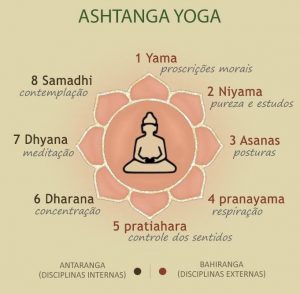Astanga Yoga
Patanjali Marshi has articulated Yoga principles very well in his Yoga Sutras and defined Astanga Yoga principles as follows:
For practice of Yoga one must follow Yama, Niyamas, which is core for progressing in Sadhana.
Yoga is mastery over the mind
“YogasChittavrithi nirodaha:” Patanjali Yoga Sutras 1.2: Yoga is gaining control of mind or mastery over mind. By controlling the mind we reach our original state. Control involves two aspects: 1. A power to concentrate on any desired subject or object and 2. A capacity to remain calm and quiet at all the time.Nature of mind is always volatile with so many thoughts, which makes one happy some time and unhappy other time. Practice of Yoga, makes one to get control of thoughts and helps to achieve mastery over mind stuff/ Chitta. When you are able to achieve this state, mind will be calm and keeps one in healthy and conscious state always.
There are eight steps in Astanga Yoga. They are:
They are:
- Yama
- Niyama
- Asana
- Pranayama
- Prathiyahara
- Dharna
- Dhyana
- Samadhi
For every individual, character development is very important part of practical education. Unfortunately these days many people are missing core values, which is causing them to go through several trouble. Niyamas helps one to purify body, mind and intellect, such that one can lead a happy life!
1. Saucha (Purification of internal and external body, mind and intellect including thoughts, speech and actions) 2. Santosha (Contentment) 3. Tapas (Fervour, austerity, inner zeal: the endurance to face the pairs of opposites such as heat and cold; joy and sorrow; regard and disregard etc) 4. Swadhyaya (Study of sciences of the self) 5. Ishwarapranidhana (Dedication / Surrender to god and work without selfish motives and work not for praise)Yama and Niyama could be considered the ten commandments of Yoga meant for controlling the passion and emotions of a person and thereby paving the way for practice of higher levels of yoga.
Asana:The third step is asana which refers to the body posture,and physical exercise to restore and refresh the body by the better circulation of blood,more effective breathing and muscular relaxation.
Sthirah Sukham Asanam: means constant confirmable body posture. Pranayama:The fourth step is pranayama. It refers to the yogic exercise of breath control used to control relax the body and thus recharge the body batteries. Prana is manifestation of all forces and power in the universe.Pranayama,therefore, refers to the certain exercises through every part of the body is filled with prana and from this vital force to a certain amount of power is generated in the body.Through pranayama one is able to exert complete control over his body,mind and emotions.
Pratyahara:The fifth step is Pratyahara.It uses the senses to gain mastery over the mind. Controlling senses from rushing towards their objects and there by control the mind. Two wards Prati and Ahara means denying the senses of their food viz.
Dharna: The sixth step is dharna.It is deep,unrestricted,pin-pointer concentration of the mind on a particular object or idea. Dhyana:The seventh step is dhyana,which is meditative awareness for instance there is a steady flow when oil is poured from one vessel to another;when the flow of concentration(Dharna) is uninterpreted, the state that arises is Dhyana(meditation).
Samadhi:The last step is samadhi,the highest level of meditation and the supreme goal of yoga. It is union with self(the divine).In the state of samadhi,the body and senses are at rest as if one is asleep but at the same time,the faculties of mind and vision or fully alert.
